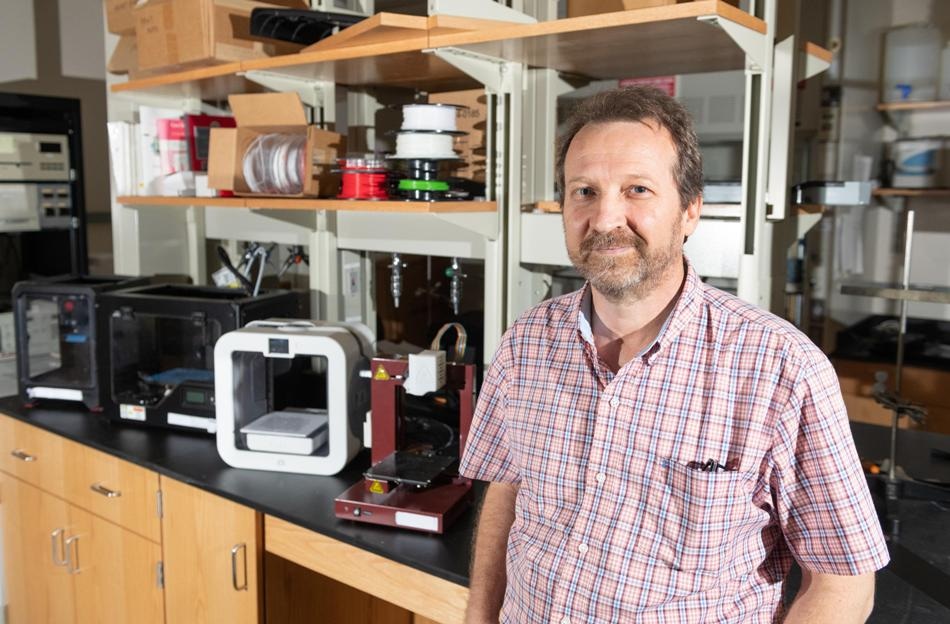Oct 9 2019
According to a study conducted by scientists from the Georgia Institute of Technology and UL Chemical Safety, in recent years, consumer-grade 3D printers have gained immense popularity, but the particles emitted by such devices can negatively influence the quality of indoor air and may also affect respiratory health.
 Rodney Weber, a professor in Georgia Tech’s School of Earth and Atmospheric Sciences, stands in his lab alongside several consumer-grade 3D printers. (Image credit: Allison Carter)
Rodney Weber, a professor in Georgia Tech’s School of Earth and Atmospheric Sciences, stands in his lab alongside several consumer-grade 3D printers. (Image credit: Allison Carter)
The study was published on September 12th, 2019, in the journal Environmental Science & Technology and funded by Underwriters Laboratories, Inc. (UL). For this study, the scientists collected particles released by 3D printers and carried out many tests to quantify their effect on respiratory cell cultures.
“All of these tests, which were done at high doses, showed that there is a toxic response to the particles from various types of filaments used by these 3D printers,” stated Rodney Weber, a professor in Georgia Tech’s School of Earth and Atmospheric Sciences, who led the study.
This research was part of a multi-year research project that focused on characterizing the emission of particles by the printers in a controlled environment and determining measures that could be employed by both 3D printer manufacturers and users to decrease the possibilities of any harm.
Even though previous studies had concentrated on quantifying the particles that were emitted, in this study, the researchers focused more thoroughly on the chemical composition of the particles and their potential for toxicity.
Normally, 3D printers operate by melting plastic filaments followed by the deposition of the melt layer upon layer to produce an object. The process of heating the plastic to melt it discharges volatile compounds, some of which form ultrafine particles that are released into the air closer to the printer and the object.
In previous research, the team discovered that usually the hotter the temperature needed to melt the filament, the more emissions were generated. Due to this, acrylonitrile butadiene styrene (ABS) plastic filaments, which need a higher temperature to melt, generated higher emissions when compared to filaments produced from polylactic acid (PLA), which melt at lower temperatures.
The researchers tested the effect of the emissions on live cells by collaborating with Weizmann Institute of Science in Israel, which exposed rat immune system cells and human respiratory cells to concentrations of the particles emitted from the printers. They discovered that both PLA and ABS particles negatively affected cell viability, where the latter triggered a more toxic response. However, these tests did not reflect real exposures.
Furthermore, the researchers carried out a chemical analysis of particles to obtain additional insights into their toxicity and enable comparisons to the toxicity of particles detected in outdoor urban environments. The analysis—known as oxidative potential—mimics the poisonous response that an aerosol may have on cellular organisms.
The toxicity tests showed that PLA particles were more toxic than the ABS particles on a per-particle comparison, but because the printers emitted so much more of the ABS—it’s the ABS emissions that end up being more of the concern. Taken together, these tests indicate that exposure to these filament particles could over time be as toxic as the air in an urban environment polluted with vehicular or other emissions.
Rodney Weber, Professor and Study Lead, School of Earth and Atmospheric Sciences, Georgia Tech
The researchers also discovered that the ABS particles released from the 3D printers included chemical characteristics that were considered different from the ABS filament.
When the filament companies manufacture a certain type of filament, they may add small mass percentages of other compounds to achieve certain characteristics, but they mostly do not disclose what those additives are.
Rodney Weber, Professor and Study Lead, School of Earth and Atmospheric Sciences, Georgia Tech
Weber continued, “Because these additives seem to affect the amount of emissions for ABS, and there can be great variability in the type and amount of additives added to ABS, a consumer may buy a certain ABS filament, and it could produce far more emissions than one from a different vendor.”
The study further analyzed which types of indoor environmental settings would be more vulnerable to emissions from a 3D printer. The researchers estimated that in a commercial building setting, such as an office or a school, improved ventilation would restrict the amount of exposure to the emissions. However, the researchers further reported that in a normal residential setting that has less effective ventilation, the exposure could be far greater.
These studies show that particle and chemical emissions from 3D printers can result in unintentional pollutant exposure hazards, and we are pleased to share this research so that steps can be taken to reduce health risk.
Marilyn Black, Sr. Technical Advisor, Underwriters Laboratories, Inc.
Meanwhile, operators of 3D printers can use a few measures to reduce their impact on the quality of air.
- Standing away from operating machines
- Operating 3D printers only in areas that have good ventilation
- Using filaments and machines that have been tested and proved to have low emissions
- Setting the nozzle temperature at the lower end of the recommended temperature range for filament materials